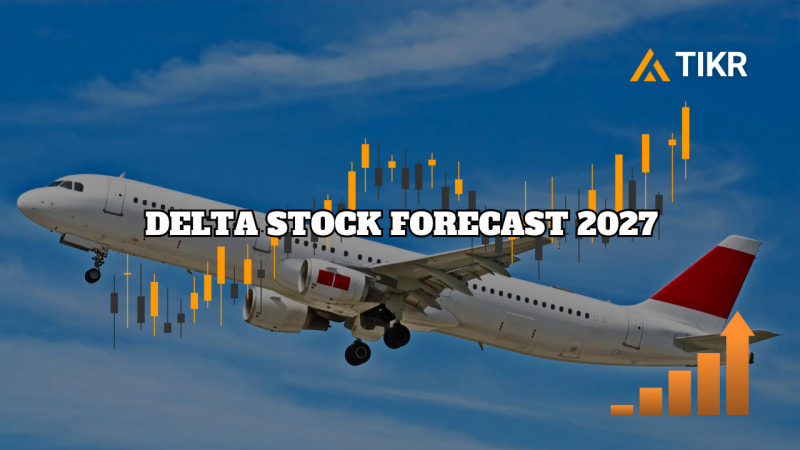Delta Air Lines, Inc. (NYSE: DAL) has recovered from the turbulence of recent years, supported by resilient U.S. travel demand and disciplined cost management. The stock trades near $61/share, up roughly 10% over the past year, reflecting a steady return to normal operations as the airline industry stabilizes.
Recently, Delta posted strong quarterly results that beat expectations, driven by higher premium travel demand and robust international routes. The company also announced new partnerships to expand global connectivity and rolled out an upgraded SkyMiles loyalty program aimed at deepening customer engagement. These moves highlight Delta’s focus on quality service and profitability, even as it navigates a more competitive and cost-sensitive environment.
This article explores where Wall Street analysts expect Delta to trade by 2027. We have combined consensus forecasts and TIKR’s valuation models to outline the stock’s potential path based on current market expectations. These figures reflect analyst estimates, not TIKR’s own predictions.
Unlock our Free Report: 5 AI compounders that analysts believe are undervalued and could deliver years of outperformance with accelerating AI adoption (Sign up for TIKR, it’s free) >>>
Analyst Price Targets Suggest Modest Upside
Delta trades at about $61/share today. The average analyst price target is near $71/share, implying roughly 17% upside over the next year. Forecasts show a balanced range, reflecting steady but cautious sentiment:
- High estimate: ~$90/share
- Low estimate: ~$32/share
- Median target: ~$72/share
- Ratings: 17 Buys, 4 Outperforms, 1 Hold, 1 Underperform, 1 Sell
Analysts view Delta as a solid recovery story, supported by improving margins and consistent travel demand. The modest upside suggests the stock is no longer deeply undervalued but could still outperform if earnings and cash flow stay resilient through 2025.
For investors, the consensus view points to steady, predictable returns rather than explosive growth. Upside potential depends on whether Delta can sustain operational efficiency and manage costs in a more competitive travel environment.

See analysts’ growth forecasts and price targets for Delta (It’s free!) >>>
Delta: Growth Outlook and Valuation
The company’s fundamentals appear stable and well-managed:
- Revenue Growth (CAGR 2023–2027): ~3.3%
- Operating Margin: ~10.7%
- Forward P/E: ~7×
- Based on analysts’ average estimates, TIKR’s Guided Valuation Model using a 7× forward P/E suggests ~$58/share by 2027
- That implies about (1%) total return, or roughly flat annualized performance
These projections show Delta is fairly valued for its current fundamentals. The limited upside reflects a mature recovery phase, with most of the rebound already priced in. The stock’s stability, supported by cost control and improving cash flow, makes it more of a consistency story than a growth one.
For investors, Delta looks like a steady airline positioned for long-term reliability. While growth may stay modest, its focus on debt reduction and operational efficiency helps provide a solid foundation through future economic cycles.

Value stocks like Delta in as little as 60 seconds with TIKR (It’s free) >>>
What’s Driving the Optimism?
Delta continues to benefit from strong travel demand, particularly in premium and international segments. Business travel has recovered faster than many expected, and steady U.S. consumer spending has helped maintain high load factors.
Management’s focus on operational reliability, cost discipline, and debt reduction also supports investor confidence. For investors, these strengths suggest Delta has the structure and scale to maintain profitability and generate healthy cash flow even in a slower travel environment.
Bear Case: Debt and Competition
Even with these positives, Delta still faces pressure from high capital costs and industry competition. Airlines remain cyclical businesses, and rising fuel or maintenance expenses could weigh on margins.
Competition from United and American continues to intensify, especially on international routes, making it harder to push through higher fares. For investors, the risk is that even modest disruptions in demand or pricing could limit free cash flow and delay meaningful upside in the near term.
Outlook for 2027: What Could Delta Be Worth?
Based on analysts’ average estimates, TIKR’s Guided Valuation Model suggests Delta could trade near $58/share by 2027, roughly in line with today’s price. That implies flat total returns over the next two years.
While that outcome would still represent operational stability, stronger gains would likely require faster debt reduction or better-than-expected margin expansion. Without a clear catalyst, Delta’s stock may stay range-bound as investors favor steady earnings over aggressive growth.
For investors, Delta looks like a dependable operator positioned for consistency rather than major upside. The story now centers on execution and efficiency, not recovery.
AI Compounders With Massive Upside That Wall Street Is Overlooking
Everyone wants to cash in on AI. But while the crowd chases the obvious names benefiting from AI like NVIDIA, AMD, or Taiwan Semiconductor, the real opportunity may lie on the AI application layer where a handful of compounders are quietly embedding AI into products people already use every day.
TIKR just released a new free report on 5 undervalued compounders that analysts believe could deliver years of outperformance as AI adoption accelerates.
Inside the report, you’ll find:
- Businesses already turning AI into revenue and earnings growth
- Stocks trading below fair value despite strong analyst forecasts
- Unique picks most investors haven’t even considered
If you want to catch the next wave of AI winners, this report is a must-read.
Click here to sign up for TIKR and get your free copy of TIKR’s 5 AI Compounders report today.

